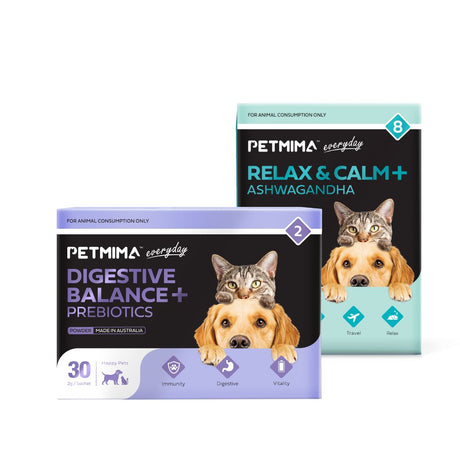Hip dysplasia in dogs is a common and often hereditary joint condition where the hip joint develops abnormally. This can lead to joint instability, chronic pain, and eventually arthritis, making everyday activities like walking, running, or even rising from a lying position uncomfortable for your dog.
The good news is that with early detection, careful management, and supportive measures such as natural supplements, low-impact exercise, and proper nutrition, many dogs can maintain mobility and enjoy a happy, active life despite the condition. Recognizing the signs and knowing how to respond is the first step in protecting your dog’s hips and overall wellbeing.
Signs of Hip Dysplasia in Dogs
Recognising early signs of hip dysplasia in dogs is essential for timely treatment. Look for:
Difficulty rising or lying down – Struggling to stand or sit smoothly.
Limping or favouring one leg – Noticeable changes in gait or stiffness.
Reluctance to exercise – Avoiding stairs, jumping, or running.
Bunny-hopping or swaying gait – Hind legs move together instead of independently.
Pain or sensitivity around the hips – Reacting when touched in the hip area.
What is Hip Dysplasia in Dogs?

Hip dysplasia in dogs occurs when the hip joint develops abnormally. Instead of a snug fit between the ball and socket, the joint is loose, causing friction, inflammation, and eventually arthritis. This can lead to chronic pain and limited mobility.
Causes include:
Genetics: Some breeds are more prone to hip dysplasia.
Rapid growth and weight gain: Extra stress on growing joints worsens the condition.
High-impact activity: Excessive jumping or running in puppies can strain developing hips.
Understanding the condition helps dog owners take preventive steps and provide better care.
Tip: Early recognition allows interventions that reduce long-term joint damage and improve quality of life.
Which Breeds Are Prone to Canine Hip Dysplasia?
Hip dysplasia occurs when the hip joint develops abnormally, resulting in a loose fit between the femoral head (ball) and the hip socket. Over time, this misalignment causes friction, inflammation, and damage to the cartilage, often leading to arthritis.
Large breeds: German Shepherds, Labrador Retrievers, Golden Retrievers, Rottweilers.
Medium breeds: Bulldog, Boxer, Staffordshire Bull Terrier.
Other breeds: Even small dogs like Pugs or Corgis may develop hip issues in some cases.
Knowing breed predisposition allows owners to monitor their dog closely and start preventive measures early.
How to Prevent Hip Dysplasia in Dogs
While genetics can’t be changed, you can reduce the risk or severity of hip dysplasia with these steps:
Maintain a healthy weight – Extra weight stresses the hips.
Provide balanced nutrition – Diets rich in protein, calcium, and omega-3s support bone and joint health.
Controlled exercise – Low-impact activities like swimming or leash walks strengthen muscles without damaging joints.
Choose responsible breeders – Ask for hip scores or health certifications to reduce hereditary risk.
Pro Tip: Puppies benefit from structured, low-impact play rather than high-intensity exercise.
Natural Support for Hip Dysplasia in Dogs
Alongside veterinary care, natural methods can support joint health and reduce discomfort:
Joint supplements: Muscle 2 Bone Advanced + Vitamin D and Advanced Bone Broth + Hydrolyzed Collagen are designed to support joint health and reduce inflammation.
Anti-inflammatory foods: Turmeric, fish oil, and omega-3 fatty acids help reduce inflammation.
Weight management: Maintaining lean body mass reduces stress on hips.
Low-impact exercise: Swimming and gentle walks strengthen muscles without worsening the condition.
Comfortable bedding and ramps: Provide support and reduce strain when moving.
Tip: Combining natural support with veterinary treatment ensures your dog stays mobile and pain-free.
FAQs About Hip Dysplasia in Dogs
Can hip dysplasia be cured?
Hip dysplasia cannot be fully cured, but early intervention, weight management, supplements, and surgery (in severe cases) can improve quality of life.
Is hip dysplasia painful for dogs?
Yes. Dogs may experience discomfort, stiffness, and limited mobility, especially after activity or as arthritis develops.
What supplements help dogs with hip dysplasia?
Supplements with glucosamine, chondroitin, MSM, and omega-3 fatty acids can support joint health and reduce inflammation. Petmima Muscle 2 Bone Advanced + Vitamin D and Advanced Bone Broth + Hydrolyzed Collagen also support joint health.
When should I see a vet?
If you notice limping, difficulty rising, or a swaying gait, consult your veterinarian for diagnosis and treatment options.
Takeaway
Hip dysplasia in dogs is manageable with early detection, preventive care, and natural support. By recognising the signs, maintaining a healthy lifestyle, and consulting your veterinarian, you can ensure your dog remains active, comfortable, and happy throughout their life.



